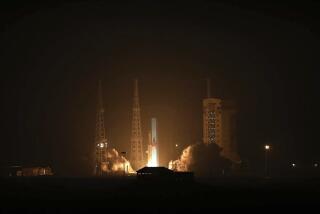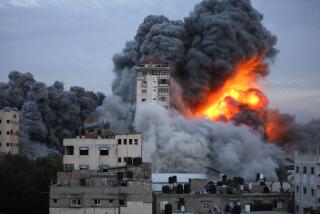Hunt for Mobile Launchers Seen as Most Difficult
- Share via
WASHINGTON — In the skies over Iraq, a deadly chase is being played out, a race pitting America’s highest technology--from spy satellites to laser-guided bombs--against Iraqi missile crews desperate to stay alive and protect Saddam Hussein’s most fearsome weapon.
At stake are the lives of American troops, the safety of thousands of Israeli civilians and the survival of the fragile but persistent Western-Arab coalition that upholds the current war effort.
The hunt for Iraq’s mobile Scud missile launchers--what President Bush on Friday called “the darned-est search-and-destroy effort that’s ever been undertaken”--is “as difficult as any military mission there is,” said David Ochmanek, a leading U.S. military analyst.
“Suppose you were told to find three dozen trucks somewhere in the state of Wyoming, and the owner of those trucks was determined to hide them. I think that gives you an idea of the difficulty,” said Ochmanek, a senior staff member of RAND Corp.
The commander of allied forces in the Persian Gulf was typically blunt in assessing the difficulty of the mission. “Finding the mobile launchers is like finding a needle in a haystack,” said Gen. H. Norman Schwarzkopf, the U.S. commander.
But as difficult as the mission is, it is also essential. Unless an actual ground assault against Iraqi troops begins, the Scuds--armed with conventional explosives or, possibly, deadly nerve gas--are the only Iraqi weapon that can pose a credible direct threat to American troops.
Perhaps even more important for the future of the U.S.-led effort against Iraq, the Scuds--as Hussein demonstrated twice in 36 hours--can be used against civilian targets in Israel.
U.S. experts and analysts disagree about whether the Iraqis are able to arm a Scud missile with a chemical warhead and fire it roughly 600 miles, the distance between western Iraq and Israel. But the second attack employing conventional warheads might be enough to force Israel to abandon its current apparent willingness to refrain from retaliating against Hussein, officials said. And any Israeli retaliation, they fear, could split the anti-Iraq coalition, forcing Arab nations to abandon their alliance with the United States and its Western partners.
“Over the next few days, I have confidence that the United States can find these missiles and destroy them,” said Jeffrey Shaffer, a military analyst at the Washington-based Center for International and Strategic Studies. “It’s a matter of racing the clock.”
The U.S. entries in that race are some of the country’s most sophisticated weapons--F-15, F-16 and F-111 fighter-bombers, loaded with cluster bombs--as well as sensitive radars, observation satellites, communications spy satellites and infrared sensors, according to military officials and defense industry experts.
Their targets, Soviet-made launch vehicles designed specifically for the 500 to 800 Scud missiles believed to be in Iraq’s inventory, are essentially specialized trucks, each about the size of a semi-trailer rig. The vehicles can be driven along highways at 20 to 30 miles per hour and hidden in aircraft hangars, small factories, warehouses, even under highway bridges or among trees in date-palm plantations.
U.S. officials said that at least 10 mobile launchers have been destroyed so far and that two others were under attack Friday. In briefings, analysts said that Iraq was believed to have had 30 to 40 launchers when the war began. In the past, however, some analysts had estimated that Iraq possessed as many as 70 launchers.
All of those under attack were in what the Pentagon calls the “Kuwait theater of operations”--Kuwait and southern Iraq, Gen. Schwarzkopf said at a briefing in Riyadh, Saudi Arabia. Mobile missile launchers in western Iraq--those used in the attack on Israel--apparently had not been tracked down as of Friday evening.
The race to find and destroy mobile missile launchers often comes down to a matter of minutes, said John Pike, a weapons expert at the Federation of American Scientists. Once the fiery plume of a missile lifting off its platform announces the position of a launcher, even a well-trained Iraqi crew would need about 15 minutes to dismantle its rig and drive to a new position. In that time, U.S. planes based in Saudi Arabia, flying at speeds of 1,000 miles per hour, could easily be on top of a target in or around Kuwait, Pike said.
“All its going to take is a truck with a low battery having trouble starting and--finito.”
But for launchers operating farther away, in western Iraq, the task is far more difficult, analysts said.
Perhaps the most common way to find the launchers is for pilots to simply look for them in suspected locations, said one of the defense industry’s top experts in surveillance, who asked not to be identified.
“It is pretty darn hard to find them, depending on the terrain,” he said. “If you are in the middle of a forest or in a city, it’s really hard.”
The Air Force’s TR-1 tactical reconnaissance aircraft in use in the Persian Gulf carries a device called a synthetic aperture radar, which provides ground photographs using radar signals. Early warning satellites, capable of detecting launches instantly, can pinpoint missiles as they take off. In addition, before launches, photographs collected by U.S. observation satellites can locate missile systems.
The satellites, however, have been badly hampered during the last two days by heavy cloud cover over Iraq. During clear weather, Pike said, the United States has seven observation satellites capable of tracking targets in Iraq, taking pictures every two hours. The satellites can detect Scud launchers by what military officials call their “signature”--the distinctive electronic signals, infrared radiation and radar profile of the trucks.
But only one of the observation satellites--capable of taking images of Iraq every 12 hours--is equipped with the cloud-penetrating radar needed for surveillance in bad weather, Pike said.
That difference is crucial because Iraqi technicians appear to have developed procedures capable of minimizing the amount of time their missiles are out of shelters and exposed to the sky.
Staff writers Ralph Vartabedian in Los Angeles and Paul Houston, William J. Eaton and Don Shannon in Washington contributed to this report.
More to Read
Sign up for Essential California
The most important California stories and recommendations in your inbox every morning.
You may occasionally receive promotional content from the Los Angeles Times.














